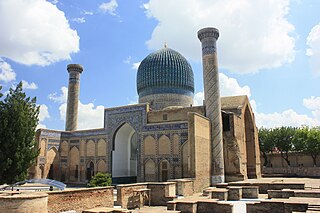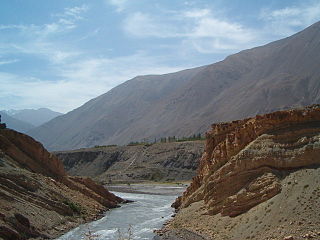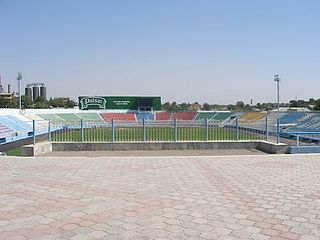
Uzbekistan is the common English name for the Uzbek Soviet Socialist Republic and later, the Republic of Uzbekistan, that refers to the period of Uzbekistan from 1924 to 1991. as one of the constituent republics of the Soviet Union. It was governed by the Uzbek branch of the Soviet Communist Party, the only legal political party, from 1925 until 1990. From 1990 to 1991, it was a sovereign part of the Soviet Union with its own legislation. Sometimes, that period is also referred to as Soviet Uzbekistan.

The Registan was the heart of the ancient city of Samarkand of the Timurid dynasty, now in Uzbekistan. The name Rēgistan (ریگستان) means "Sandy place" or "desert" in Persian.

The Gūr-i Amīr or Guri Amir, is a mausoleum of the Asian conqueror Timur in Samarkand, Uzbekistan. It occupies an important place in the history of Persian-Mongolian Architecture as the precursor and model for later great Mughal architecture tombs, including Gardens of Babur in Kabul, Humayun's Tomb in Delhi and the Taj Mahal in Agra, built by Timur's Persianised descendants, the ruling Mughal dynasty of Indian Subcontinent. It has been heavily restored.

Zarafshan River is a river in Central Asia. Its name, "spreader of gold" in Persian, refers to the presence of gold-bearing sands in the upper reaches of the river. To the ancient Greeks it was known as the Polytimetus. It was also formerly known as Sughd River.

Shah-i-Zinda is a necropolis in the north-eastern part of Samarkand, Uzbekistan.

Dinamo Stadium is a multi-use stadium in Samarkand, Uzbekistan. It is currently used mostly for football matches and is the home stadium of Dynamo Samarkand.

The Ulugh Beg Observatory is an observatory in Samarkand, Uzbekistan. Built in the 1420s by the Timurid astronomer Ulugh Beg, it is considered by scholars to have been one of the finest observatories in the Islamic world. Some of the famous Islamic astronomers who worked at the observatory include Al-Kashi, Ali Qushji, and Ulugh Beg himself. The observatory was destroyed in 1449 and rediscovered in 1908.

The Samarkand Oblast was an oblast (province) of the Russian Empire between 1868 and 1924. It roughly corresponded to most of present-day central Uzbekistan and northwestern Tajikistan. It was created out of the northeastern part of Emirate of Bukhara. It consisted of the uyezds of Samarkand, Dzhizak, Katta-Kurgan and Khodzhent.
The Shahrisabz Museum of History and Material Culture is a museum in Shahrisabz, Uzbekistan. It was founded in 1996 on the 660th anniversary of Amir Timur's birth and contains arcaheological, ethnographic, and numismatic collections.

Samarkand State University (SSU) is a major university in Samarkand, Uzbekistan established by a government decree of the Government of Uzbekistan dated 22 January 1927 in the city of Samarkand. The university is commonly known as Samarkand University

The Ulugh Beg Madrasa is a religious educational institution in Samarkand, Uzbekistan. It was built by Ulugh Beg during the Timurid dynasty at the Registan in the heart of the ancient city of Samarkand.
Urda was the fortress, built by Kokand people after the conquest of Tashkent.

The St. John the Baptist Church It is the only Catholic church in the city of Samarkand, in the Asian country of Uzbekistan, where 95% are Muslims. It depends on the Apostolic Administration of Uzbekistan based in Tashkent.

Afrasiab Museum of Samarkand is a museum located at the historical site of Afrasiyab, one of the largest archaeological sites in the world and the ancient city that was destroyed by the Mongols in the early 13th century. Museum building and the archaeological site are located in the north-eastern part of the city of Samarkand in the Central Asian country of Uzbekistan. It bears the name of Afrasiab, mythical king and hero of Turan. Permanent exhibition of the Afrasiab Museum of Samarkand is focused on the history of the city itself as well as the surrounding region. The museum building was designed by Armenian architect Bagdasarov Arzumanyan in 1970, at the time when Uzbek Soviet Socialist Republic was still part of the Soviet Union. The opening of the museum was dedicated to the 2500th anniversary of the founding of the city of Samarkand. Thematically, the museum is divided into five rooms dedicated to different periods of life in the fort of Afrasiyab.





















